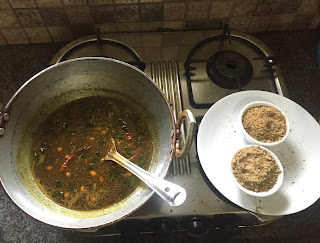Before you start to read this blog, let me confess that I have made Pulikaachal very few times. And though we are Iyengars, I have never seen my mom or dad make Pulikaachal or Puliyodharai, ever.
But somehow, luckily, every time I have made it, it has always come out quite tasty. And people who have tasted it (read my mom-in-law and my husband's aunt) think I make it so well, probably because we are used to it (the Iyengar cliche`), but no! If I can make this, so can anyone.
This time around, I referred to two recipes (mostly what my cousin had shared what her mother-in-law had written down for her, and also from an online source) and did my own customization. I have used the term serving spoon instead of table spoon here referring to the large ladle we use to serve food. I hate measuring ingredients but I am doing my best here :)
These quantities I have used below yielded about 700 grams of pulikaachal paste for me. You can adjust it according to your requirement.
Ingredients:
To Roast and grind:
Black sesame seeds - 2 tsp
Channa Dal - 2 large serving spoons
Urad dal - 2 large serving spoons
Coriander (Dhaniya) seeds - 2 tsp
Fenugreek (Vendhayam) seeds - 1.5 tsp
Asafoetida - 2 tsp
Jeera - very little (optional)
Black pepper - I used about 1 tsp.
Red chillies - 10-15 depending on your taste and appetite for spice. You can add more if you are adding jaggery.
Other ingredients:
Tamarind: About 125-150 grams.
Sesame (Gingely) Oil: 6-7 serving spoons.
Channa Dal - 1 serving spoon for tempering
Ground nuts- 2 serving spoons.
Mustard - 3 tsp
Curry leaves - a handful
Red chillies - 4 to 5
Jaggery: a little (optional). I would recommend using jaggery to get the right balance in taste.
Turmeric powder - 1.5 tsp
Salt - as per taste.
Method:
Dry roast the sesame seeds first and keep aside once they splutter. In the same pan, add a tsp of oil and fry all the dals and other ingredients mentioned under "Roast and grind". Once the dals turn golden brown, keep aside and let them cool after which you can grind them all to a fine powder.
Soak tamarind in hot water and extract a thick pulp. Dissolve jaggery (i used a small piece) in a little water, boil and filter out any impurities. Combine both the tamarind pulp & jaggery water in a vessel and add turmeric and salt to this. Stir this mixture and leave it on the stove to boil for about 8-10 minutes.
 |
| Jaggery water, tamarind pulp,roasted ingredients and the serving spoon(ladle). |
Take a fresh pan. Pour remaining oil into it. Once its hot, throw in the mustard seats and let them splutter. Add the channa dal (the one set aside for tempering), ground nuts and curry leaves and stir it around a bit. Add some red chillies to this. Once the colour of the dal turns golden brown, pour the tamarind water mixture into this and ladle it around for a few minutes.
 |
| Tempering in oil. |
 |
| Tamarind-jaggery water poured inside the pan. |
Switch off the stove and wait for a couple of minutes. Now stir in the powder that you have ground and ensure there are no lumps. Switch back the stove on in "simmer" mode and keep cooking until the pulikaachal reaches the right consistency.
A small tip: When you taste the pulikaachal for salt, if it seems just about right, you may want to add a bit more even if it's a tad more saltier than you like it. This is because when you mix it with rice for making the Puliyodharai, the salt will balance out. You needn't keep adjusting for salt at that point.
 |
| Finished Pulikaachal |
Transfer the pulikaachal into a dry container and ensure you always use a dry spoon to scoop it out.
Mix it with boiled rice for Puliyodharai. Refrigerate Pulikaachal for longer shelf life. The paste might become a bit dry over time. You can add some gingely oil to it as and when you mix it with rice.




No comments:
Post a Comment